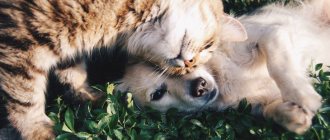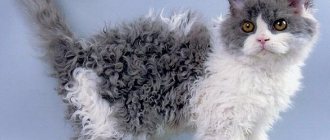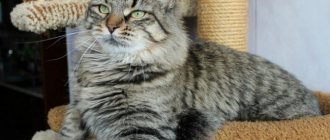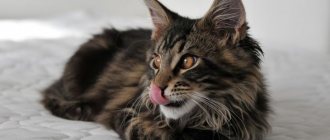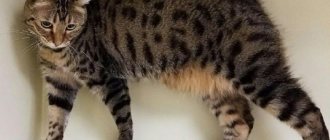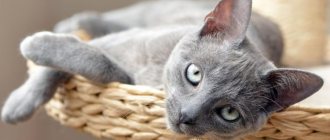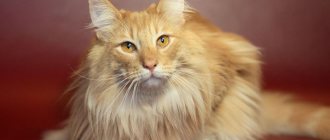Cat breeds with tufted ears are in demand. Many are looking for certain species and are willing to pay significant money, sometimes even a fortune, for such gorgeous animals. They are beautiful, graceful, friendly, and over time, such pets become members of the family.
Cats with long hair usually have ear tufts. The distinctive breed characteristic of a cat is more pronounced at an early age. As they grow older, the tassels become invisible.
The significance of tassels for wild animals has not been clearly established.
Experts have different points of view on this matter.
- The first version is that the brushes play the role of an amplifier of sound waves. With their help, the animal quickly determines the source of sound, catches minor rustles and voices of rodents hiding underground or in snow cover.
The brushes help to catch the sounds of an approaching enemy at a distance of several kilometers.
This version is considered not very true, although there is an opinion that without brushes a cat hears worse.
- Another theory suggests considering the tassels as a beacon, with the help of which animals can see each other from a distance.
- The third version claims that tassels are indicators of a cat's maturity. Their length determines the age and experience of the animal.
Today, a special place in the list of popular pets is occupied by a breed of cats with tufted ears.
Cats with tassels on their ears, while maintaining a formidable and warlike appearance, have actually acquired the ability to get along at home and become a friend and favorite of a person.
Maine Coon
This breed is a semi-long-haired cat. The breed was bred in the USA, and is one of the largest purebred representatives in the world, created to live next to humans. This is a large breed of cat, with an extraordinary appearance, a variety of colors and an affectionate character.
The Maine Coon first appeared in Northeast America, in the state of Maine, about a hundred years ago. Part of the animal's name is associated with this area. The second component of the name in translation means raccoon or lynx, which is explained by the similarity of the fur coat with the coat of a raccoon. And with the presence of tassels, cats resemble a lynx.
The breed developed in northern climates, which explains the appearance of wide bones and long hair between the pads on the paws. Size does not match weight. Males weigh more than 10 kg. This breed of tasseled cats entered the Guinness Book of Records thanks to an amazing specimen weighing 16 kg.
Character
The Maine Coon is distinguished by its character and interesting features:
This ear-tufted cat adores her family and doesn't require much attention herself. They do not like loneliness; if you have to leave her alone for a while, you need to purchase various toys for the cat so that she does not get bored before the owners arrive. They love water and water procedures very much. There should always be a bowl of water next to the food for your pet to splash into. Maine Coon is able to communicate using different sounds. In addition to meowing, they make sounds similar to squeaks and trills. They have developed body language. If a cat wants to express a special reverent attitude, it hits its head. The breed is adapted to living in any climatic conditions. They can withstand winter cold and snowy weather without problems. Very friendly. The color of cats of this breed with tufted ears varies in 75 different color combinations. The breed includes both ginger cats and individuals with a chocolate color; lilac-colored specimens are possible, although these variations are recognized as a deviation from the standard and are not the norm for this species.
Maine is a coon with a half-meter tail, long hair, wide strong paws, powerful muscles and a large head. The cat's head is elongated, high cheekbones, triangular ears with tufts. The eyes of Maine Coon cats are oval-shaped, the color should be in harmony with the coat.
Care
Caring for this breed is easy:
- The coat needs to be brushed daily; Provide her with a scratching post;
- For food and water you need to place separate bowls, preferably made of glass or stainless steel;
- It has a tendency to develop periodontal disease; to prevent the disease, you need to regularly brush your pet’s teeth.
- The animal should be provided with its own corner, as it needs privacy from time to time. When the cat is in its corner, you should not touch it, so it will feel safe.
- It is recommended to feed the Maine Coon dry food, which will keep the teeth in good condition.
You can add to your diet:
- Raw beef;
- Cottage cheese;
- Quail eggs;
- Boiled chicken.
The Maine Coon is a breed of cat with tassels, included in the list of the most expensive species in the world ($4,000 to $80,000).
Origin of breed characteristics
The most interesting legend about the origin of the breed concerns one ancient cat whose tail was pressed under the door due to constant lateness. This action occurred regularly, so that each new litter of kittens was born with shorter tails, until the resulting appendage was reduced to a few vertebrae.
Since then, short-tailed cats have had creases and knots on their short stumps, which they inherited from their ancestors.
The following myth classifies representatives of short-tailed breeds as descendants of the lynx family. There are indeed common features in their appearance that can convince anyone of the validity of such conclusions. Even the chromosome map of two species contains 38 elements - the most important fact from supporters of such a theory.
The next hypothesis, unlike previous stories, looks more plausible. The kittens were born with normal tails, but the mother cats chewed them off because the cubs did not fit in the cramped den.
It was by the tail that the predator could pull the kitten out of the hole. Later, a natural mutation occurred, as a result of which short-tailed breeds appeared.
And the last version, which is related to genetics. By a strange coincidence, all tailless breeds originate either on island territories or in states with a closed way of life.
Representatives of the most ancient breed of cats with a short tail - Japanese Bobtails - came to the islands from Ancient China. For several centuries they lived in isolation. Under such conditions, it is possible to launch the natural process of inbreeding (inbreeding), which can cause genetic abnormalities.
At the other end of Europe, off the coast of Ireland, on the Isle of Man, a similar story happened. Here, local cats with short tails have been known for several centuries, but they only got outside their territory at the end of the 19th century, when they represented an already established and stable group.
Norwegian forest cat
Officially, the World Cat Federation registered this cat with tufted ears in 1970. Norway is recognized as the birthplace of the breed. Amazing and strong animals stand out from other pets.
Peculiarities
The breed is quite special; the Norwegian Forest has a number of specific characteristics;
Thick coat with water-repellent wool; Massive but flexible skeleton, elongated body, powerful muscles; Large triangular head; The ears are large, with tufts on the edges; The paws are oval, the limbs are high, there are woolen brushes between the phalanges; The eyes are large, round in shape, the color matches the coat; The tail is straight, fluffy, reaching the shoulder girdle; This cat with tassels on her ears is the owner of whiskers that stick out in different directions;
Character
The Norwegian Forest is a tasseled cat breed that is a combination of a wild hunter and a cute pet. They have a lot of wonderful character traits:
Patient and reserved. They can play with children for hours; Get along well at home; Easy to train; They love to sleep, but when they wake up they play and hunt happily; Freedom-loving, they prefer to walk in the fresh air, and therefore such cats need to be kept in large apartments or in private houses. If a Norwegian cat lives at home, you need to protect poultry and rodents from him, because they are born hunters.
Small kittens of the Norwegian cat look like balls and you can hold them in your hands for hours. But an adult forest animal will not tolerate this. They can lie down next to the owner, they will allow you to pet them, but only when it is pleasant for them too.
Care
This breed is very hardy, with good health. They rarely get sick, are not afraid of cold weather, and are the longest-livers among other species. They love active games.
Has no special requirements. You need to regularly walk on a leash, have vaccinations and examinations by a veterinarian, provide adequate nutrition, and brush daily.
If they don’t like something, they won’t take revenge; they’ll just leave home!
Chausie
A domestic cat that looks like a wild one was artificially bred in the USA. Its name, chausie, comes from Felis chaus, which is translated from Latin as “reed cat.” The breed was developed in the middle of the last century as part of a program against keeping wild cats in captivity. By crossing the wild jungle cat (swamp lynx) and aboriginal domestic cats, breeders achieved the preservation of wild external features combined with an affectionate and friendly character.
From its wild ancestor, the Shawsie inherited large size, a strong muscular body with ideal proportions. There are lynx tassels at the tips of the wide, large ears. Despite its impressive dimensions, the Shawsie moves quickly and gracefully, like a real wild predator.
A distinctive feature of the Shawsie is its “wild” color. Only representatives of this breed have the color characteristic of the swamp lynx. The coat is short and very dense with a well-developed undercoat, which allowed the cat's wild ancestors to make their way through dense undergrowth in pursuit of game. Hunting instincts are also manifested in the behavior of a domestic cat.
Shausie gets along well with all the inhabitants, but is not averse to running after a ball or other toy, imitating a hunt. This is a very curious, restless and active animal. Shausie also loves to climb, jump, and run. A city apartment cannot provide an outlet for a pet's energy. Large sizes and a love of active games require the space of a country estate.
Pixie - bob
Quite a rare breed of cats with tassels. Reminds me of a lynx. The pet easily gets along at home, it can be easily trained to obey commands and taken for walks on a leash. They love to walk in the fresh air.
They love to talk and therefore meow a lot.
This breed with tufted ears has a soft, unobtrusive and affectionate character. The only thing they require is contact with a person, without this the animal will go wild.
Pixie Bob has a large build, strong paws and a short tail. The breed's coat is soft and can be either short or long. The muzzle has a chin and plenty of fur.
Wild pets
Cat enthusiasts are constantly experimenting with certain wild species that have a trait they are interested in. Therefore, cats with round ears are consistently in the field of view of breeders.
Serval
African predator, lives in the northern part of the continent. It reaches one and a half meters in length, 65 cm in height and weighs up to 20 kg
Rounded large ears and beautiful spotted colors traditionally attract the attention of breeders who are engaged in breeding new breeds to the serval.
These cats show distrust of humans, do not get along well and, no matter how much care they take, remain untamed for the rest of their lives. The exception is pets that came to people at an early age, but even after reaching puberty they dramatically change their behavior.
But the servals showed their best side in parenting qualities. They easily find a common language with ordinary domestic cats and have offspring with them. Some of these hybrids have become very popular.
Savannah
A hybrid of a serval and several domestic breeds. At various stages, Oriental, Bengal cats, Ocicat and Egyptian Mau took part in the selection. The result was a large animal that inherited from its wild ancestor its height (up to 60 cm), weight (15 kg), spotted predatory coloring and large ears with round tips. A very impressive and wayward cat.
Like other hybrids of wild animals, all offspring of the Savannah are marked by blood. F1 is a direct descendant from the first mating of an African cat (50% serval). In categories F1-F4, all cats remain sterile and cannot have offspring. Therefore, only females are suitable for further reproduction.
They are bred with domestic cats (usually the Bengal breed is chosen) and continue the savannah bloodline. The F5-F7 group is represented at home. She no longer has the hunting alertness and wild aggressiveness, but all the qualities of ordinary domestic cats are manifested.
Chauzie
The breed is the result of crossing an ordinary cat and a jungle cat.
Character
Shawzis are lovers of active games. They cannot stand loneliness. They willingly participate in all the affairs of family members. They are strong friends with children and can play with them for hours. Very curious and can leave the house through the window, you should be more attentive to her.
Breed characteristics and care
Chausie has short hair and a thick undercoat; The color of the animal can be silver, gold, black. Shausi's physique is strong, his muscles are well developed, his limbs are long, his paws are of medium size; The ears are large. Closer to the base they are wide, the edges are narrowed with tassels; The eyes are slanted. Specimens with light green and amber eyes can be registered in the breed; This breed only needs to be brushed during the shedding period.
Canadian Sphynx
One of the oldest breeds, which has won the hearts of people with its more than extraordinary appearance - an elongated, “faceted” muzzle, bare “velor” skin, the intelligent look of lemon-shaped eyes and huge ears, like those of a bat. The first “officially described” Sphinx lived in Ancient Egypt. A white blue-eyed cat guarded the Sanctuary of Ancient Egypt.
The Don and Petersburg (Peterbald) sphinxes are also “noble eared animals” with a naked body, although they are not relatives of the “Canadians”. Both breeds were developed in Russia, and the Peterbald was created by crossing the Don Sphynx and the Oriental cat.
Hairless cats have a “dog-like disposition” and require special care. Contrary to popular belief: “no hair, no problem,” caring for Sphynx cats is more problematic than caring for Angora or Persian cats. Daily skin cleansing, strictly balanced nutrition and clothing that protects the cat from hypothermia. The Sphinx is a child in need of care with the look of a sage and the appearance of an alien creature.
Caracal
This graceful and majestic animal is an inhabitant of Asia and Africa. Translated, the name of the breed means “black ear”. This cat with tassels on her ears has sharp eyesight and sensitive hearing. The paws are powerful, the body is strong. When hunting in nature, she is able to catch prey larger than herself. The animal is wild; people tried to tame it back in Ancient India and Persia. The purpose of taming was to use the animal for hunting.
Today, a tamed caracal costs from $10,000 and is a sign of wealth among wealthy people who value exotic things.
This wild cat with tassels on her ears behaves very sweetly and friendly at home. However, it is not recommended to have it at home where small children live.
Characteristic indicators
The color of the animal is reddish-sandy or sandy. The tassels and outer side of the ears are black.
Body length is about 80 cm, tail up to 30 cm, shoulder height 45 cm, weight reaches up to 20 kg. The fur is short and thick.
Features of maintenance and care
It is better to buy a kitten at 6 months; at this age, the predator quickly adapts to others; You need to know that the caracal does not tolerate rudeness and punishment; In a caracal, fun and attacks of aggression can alternate; you need to be prepared for such a course of events, regularly consult with specialists; It is better to keep a caracal in a private house with a high fence; Your pet's claws need to be trimmed periodically with special scissors; Basically, such animals are trained for the tray in the nursery and there are no special difficulties associated with this at home. They, like other cats, do not bury their excrement, but leave the contents of the tray on the surface; The animal does not tolerate cold well. A lover of water treatments; A caracal should be combed no more than once a week using a furminator. You should bathe when the cat is very dirty. A properly raised caracal will become not only a good friend, but also a reliable guard for the home.
Varieties
There are more than 350 species of shrews. Only 25 of them are found in Russia. The most common types of long-nosed mice are:
- Common shrew. It can reach 8 cm in length, while its weight does not exceed 160 g. The body is covered with soft brown fur. A nose with a blunt tip is clearly visible on the head. The length of the animal's tail is equal to the length of its body.
- Tiny shrew. It got its name due to its very small size. Its weight is only 3 g, and its body length is 5 cm. The animal is recognized as the smallest representative of the mammal family. His nose is like a proboscis, and his short fur is gray-brown.
- House shrew or long-tailed shrew. This mouse can often be found in the vegetable garden or garden. For the winter, she moves to cellars or basements of private houses. The body length of this long-nosed mouse is about 8 cm, and the tail is up to 5 cm.
Tiny shrew
Siberian cat
Ancestors of the Siberian cat from Taiga. The breed was officially registered in the 80s. Today, most of these furry animals live abroad.
This breed is classified as semi-longhaired. The tufts on the ears of Siberians can be clearly defined or not visible at all.
The physique of Siberian cats is massive, the limbs are distinctly strong. The head is trapezoidal, round, of medium size. The weight of a Siberian cat is about 6 kg. Cats can weigh up to 12 kg.
The tail is wide. The eyes may be yellow or green.
Color - gray, with brown and black weaves.
The peculiarity of the breed is that they take a long time to mature. Their period of maturity begins at 5 years.
Character
The breed of these cats with tassels on their ears is considered one of the "universal" ones.
Their character is strong, but at the same time they are affectionate and friendly. Affection is always welcome.
It gets along well both in a private house and in an apartment, as the breed is very neat, with a high sense of tact.
They get along great with children. They will be friends with other animals living at home. They do not tolerate rodents. Its prey can be a rabbit or a ferret living together in the house.
The Siberian cat is fearless. She may not let a stranger into the house, warn the owner about the approach of people who seem suspicious to her.
He loves to give gifts to his owner, sometimes bringing home something in his teeth.
The breed loves to climb high objects and play with toys. Smart like no other breed. Before doing anything, he thinks about the correctness of the action.
Thanks to the specificity of wool, they relieve pain caused by osteochondrosis.
Care
Siberian cats love walks and can walk outside even in winter; It is better to feed the breed natural food, with vitamin supplements; You need to regularly clean the animal’s ears with oil-based cotton balls, and its eyes with just damp ones; They are in good health, but require all prescribed vaccinations. Tassels are evidence that they are carriers of the genes of their wild counterparts, and therefore, when purchasing such a breed, you need to be prepared to give your pet personal space. Such cats are distinguished by intelligence and loyalty, they are freedom-loving, they like walks in the fresh air. They demand respect in return for their devotion and love. Having fallen in love with their owner, cats of this type will take on the responsibilities of his protector!
"Aborigines" from the Isle of Man
This is roughly the name given to the Manx cats that settled on the Isle of Man in the Irish Sea. How they got there is not known for certain, although there are many versions: from biblical to modern scientific.
Today there are 4 varieties of Manx. Depending on the length and shape of the tail, cats are divided into:
- Rampi (sacral). The tail is completely absent.
- Riser (growth). Instead of a tail, there is only a small protrusion on a couple of vertebrae. -9
- Stumpy (short). A small tail measuring 4-8 vertebrae.
- Longi (long). Quite a long tail, almost identical to the “classic” length.
- Rumpy
- Stumpy
- Riser
- Long
If we talk about character, animals are cheerful and energetic. They love active games, love to climb trees and have enviable jumping ability. The habits of cats are somewhat similar to dogs, in particular, this concerns learning various commands. Since Manx cats are very sociable, they are not recommended for people who are rarely at home.
Another distinctive feature of this breed is its excellent hunting qualities. Owners of such pets should be calm about the fact that prey in the form of mice, rats, moles and other garden and dacha “fauna” will be brought into the house. Manx cats will always find a common language with children, even when the baby is too persistent in showing his love and tormenting the cat with annoying caresses.
Lynx-like felines that can live with humans
Lynxes are not the only representatives of the family with long hairs on their ears and camouflage coat color. Among wild relatives, caracals and jungle cats have the greatest external resemblance to the famous predator. They also live in the wild, but can live with humans. However, for their maintenance it is necessary to create conditions close to the natural environment.
Caracal - steppe lynx
The caracal is called the steppe lynx. Wild caracals are found in Africa, Central Asia, the Middle East, and in some areas of Turkmenistan, Kyrgyzstan, Uzbekistan and Dagestan.
Caracal
Caracals have a slimmer build and weigh 11–12 kg. The tall, straight ears have distinct, long dark hairs. The steppe lynx's fur is dense, short, and has hard bristles on its paws. A distinctive feature of the caracal is its reddish coat without spots. In addition, the animal has a fairly long tail, growing up to 30 cm.
Baby caracals
Kittens born in the wild will not be able to become pets. Only animals born from individuals kept in captivity can live with humans. It is better to keep domesticated caracals on the territory of country houses, where they will have the opportunity to move freely over a large area.
When keeping a caracal at home, special attention should be paid to nutrition. A predator's diet must include raw meat, poultry, and eggs.
Some owners of these exotic pets feed them premium or super-premium dry ready-made food.
It is not recommended to have caracals in a house where there are small children.
A predator has very strong natural instincts, so if handled carelessly, it can quickly hit back at the offender.
Jungle cat - marsh lynx
People were able to tame the jungle cat 3 thousand years ago. The people of Egypt were the first to do this. They called it house, which meant "house", because the animals lived in people's houses. Another nickname for the animal is the swamp lynx. These animals do not like to go out into open areas. They live in reed thickets, among bushes growing on the banks of water bodies, and often hunt for fish and waterfowl. Animals visit human settlements only when there is a lack of food. They raid chicken coops.
jungle cat
Populations of these predators are mainly found in regions with warm climates. They live in Africa, Central Asia, the Caucasus, and also live in India, Palestine, and Thailand. In Russia, animals can be seen on the Volga coast and in Dagestan.
This predator is similar to a lynx in the color of its coat, but is smaller in size. The body length of the jungle cat is about 90 cm, the weight of the largest individuals reaches 12 kg, the height at the withers does not exceed 0.5 m. Small spots on the body are almost invisible in adult individuals, they are more pronounced in kittens.
The jungle cat becomes a pet only in exceptional cases. Developed natural instincts make it dangerous even for the owner who has lived nearby since childhood.
You can keep a swamp lynx in an area where it can freely hunt, swim and walk. The proximity of other pets to a wild cat is unacceptable.
Chinese Crested
This long-eared pet will conquer all family members. The dog at the withers reaches 25-35 cm and weighs 3-6 kg. There are three main varieties of Chinese Cresteds:
- Powderfs have thick, long fur all over their bodies; for such pets you will need to stock up on sharp scissors for cutting; you can also buy a machine for cutting hair in the area of the paws and neck;
- Koniks do not have much hair, only in the head area, limbs and tail. This gives them a special charm.
Despite their “woolly” variety, they do not shed, and the wool does not roll down the carpet. Lots of fur, this is not about the crested one. The dog will be just an ideal friend for your children, crested, in itself, affectionate in communication and sensitive to the mood swings of the owner. Although, due to their unusual appearance, not everyone likes them.
Norwegian cat
It has been officially known since the 16th century, but judging by the fact that it is sometimes named among the possible ancestors of the Maine Coon and is associated with the Vikings, it appeared alongside humans long before the first mentions in sources. In some sagas, for example, you can find a mention that the god Thor was always accompanied by a certain “fluffy forest beauty”, whose description is very similar to a Norwegian cat.
Be that as it may, the owners of livestock farms knew this cat very well. After the Second World War, it was on the verge of extinction, so even some special measures were taken, supported by local authorities, to ensure that this species did not completely disappear into the darkness of History. The measures turned out to be effective, and today this cat is quite common not only in Scandinavia, but also in other countries of the world.
It is valuable and attractive to lovers of all things feline for many reasons, and above all for the following:
- a beautiful fluffy coat with a water-repellent layer and a thick undercoat, which allows its owner not to freeze. Of all the variety of colors allowed in the breed, four types are most often found - black, red, gray and white.
- large sizes. The average weight of a Norwegian cat reaches 6-8 kg.
- good health. It has been noticed that these cats can live to old age without ever getting sick.
- patience, gentleness and friendliness. Like all cats in the world, they love affection, but for some reason they do not like to sit on laps.
- activity and mobility. It's rare to see a Norwegian cat lying imposingly on the sofa. Basically she is always on the move. She loves various games, especially those simulating hunting: this is how her hunting instinct manifests itself.
- longevity. There is evidence that cats of this breed can live up to 20 years or more.
- sociability, dignified behavior, the ability to get along with other animals and lack of conflict.
- pronounced love for children.
As an interesting fact, it can be noted that the notorious tassels on the ears of the “Norwegians” are weakly expressed.
Norwegian Forest Cat
